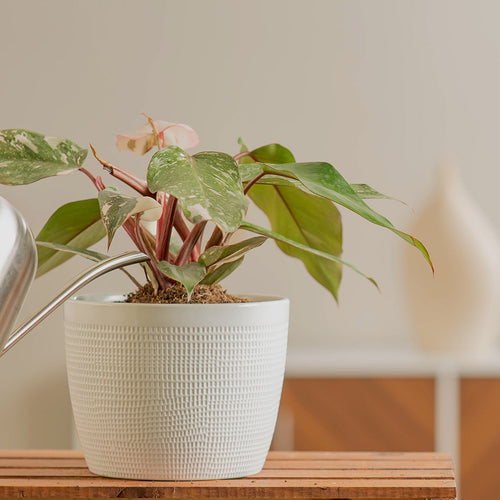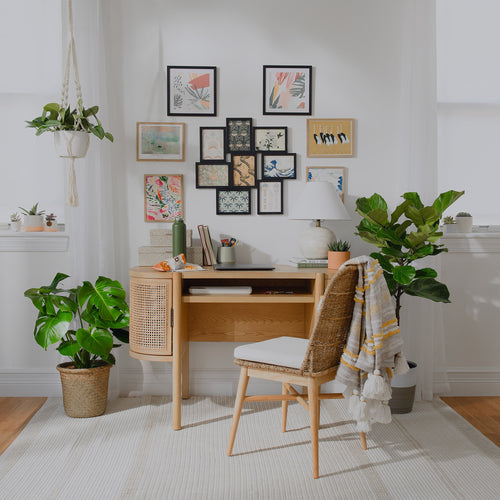
Bi-Color Glory
Make a big impact by teaming two of your favorite colors together in a window box. Here, red and white petunias, red nicotiana, red verbena, and snow white euphorbia look stunning in a freshly white-washed wooden window box on a Maine cabin. All of these beauties require at least 6 hours of direct sunlight a day.Window Box Tip
Make sure your window boxes are securely fastened in place to prevent them from toppling when the soil is heavily saturated.

First Acts and Finales
Cool weather in the spring and fall may limit the variety of flowers who can play starring roles in your window boxes. But, don’t worry, you can always rely on pansies to keep the show going when temperatures are low. Plus, pansies come in an almost unlimited selection of colors, bi-colors, shapes, and sizes. It was just 45F when we photographed this pack of happy pansies on a New England street.Window Box Tip
Window boxes should measure at least 8 inches wide and 10 inches deep in order to accommodate the roots of most plants. Also, the more soil your window box can hold, the less quickly it will dry out.

From the Ground Up
On a single story stucco or brick home, you can get the look of a window box without fastening anything into the mortar when you create a custom planter box directly under your front windows. Here, a brick/stucco planter that matched the home’s exterior was built right along the front of this Florida ranch house. It holds a gorgeous collection of blue salvia, white sweet alyssum, red petunias, white verbena, pink dianthus, and creeping Jenny.Window Box Tip
Drainage holes, that allow excess water to escape, are especially important with window boxes. You don’t ever want your boxes to get waterlogged.

Go Big, Go Bold
When it comes to window boxes, bigger is better especially if your home has a series of windows mounted together. Instead of making a separate boxes for each window or just putting one box under the center window, why not spread things out a bit with one, 6-foot long box that spans all the glass? That’s what this South Carolina homeowner did for a traffic-stopping effect. Pink phlox and chartreuse ornamental sweet potato and succulents provide bold accents from one end to the other.Window Box Tip
Mixing annuals, perennials, and succulents together is a great way to insure your window box is constantly colorful from spring to fall.

Match Your Style
Always choose window boxes that complement your home’s architectural style and color. On this Colonial style home with black shutters, the owner opted to go with a muted color palette that reflects the home’s historical and coastal heritage. Here you find an island of bronze-leaved begonias awash in a sea of gray-green artemisia with a foamy white accent of euphorbia.Window Box Tip
To keep your plants in top form all season long, sprinkle some slow-release granular fertilizer over the surface of the soil at planting time. That way, your flowers will get fed every time they are watered.

Low-Maintenance & Lovely
When selecting plants for your window boxes look for those that suit your lifestyle. If you travel a lot, for example, choose low maintenance plants that don’t mind going a few days without a drink. For short vacations consider Big Leaf or Dragon Wing begonias. These showy beauties are surprisingly drought resistant and can be left to their own devices over a long weekend. In this window box they are paired with the equally drought-resistant gray licorice plant.Window Box Tip
Include trailing foliage plants such as ornamental sweet potato, creeping Jenny, licorice plant, dichondra, ivy, and inch plant in your window box mix. Their trailing habit and consistent color keep things interesting all summer long.

Shades of Green
Who says, green isn’t a color? Filling your window boxes with varying shades of green is a great way to make a cool, calm statement during the dog days of summer. Here, the tall spiky foliage of Foxtail asparagus fern plays the role of “thriller” plant alongside a “filler” of green and maroon coleus. Trailing chartreuse creeping Jenny acts as a cheerful “spiller” plant cascading over the edge of a rough hewn wooden window box.Window Box Tip
For interest and drama, mix textures as well as colors. When you visit your garden center look for plants with puckered, pointy, fuzzy, or shiny foliage.

Quick & Easy
Looking for a quick way to add color to a shed, garage, or home? Try using English style “hay racks.” These metal forms contain a coir liner that hold the soil and plants in place. Plus, they are easy to install and come in a wide variety of sizes. Just attach them to a wall, add soil, plants and water. That’s it! Here, a garden shed is decked out for spring with two varieties of primula and pussy willow twigs for added flavor. Just remember that hay rack baskets can dry out quickly and may require daily watering.Window Box Tip
Always plan for at least two (or more) seasons of color. Early bird bloomers such as pansies and primula will fade when the weather warms up. Then, replace them with summer flowers that love the heat. And, come fall, you can replace them with another crop of cool weather plants.

No Water? No Worries!
Keeping a window box hydrated during hot, dry weather can be challenging. Instead of dragging out the garden hose every day, just fill your window boxes with succulents that aren’t heavy drinkers. Here, low-water beauties such as snake plant and sedum rub shoulders with a mixed bag of succulents such as crassula and echeveria. What’s more, all of these plants do just fine in a variety of light conditions.Window Box Tip
Because succulents don’t mind being crowded, you can pack them in tighter than other plants, creating a finished look right away. Mix succulents of different shapes and colors together for best effect.

















